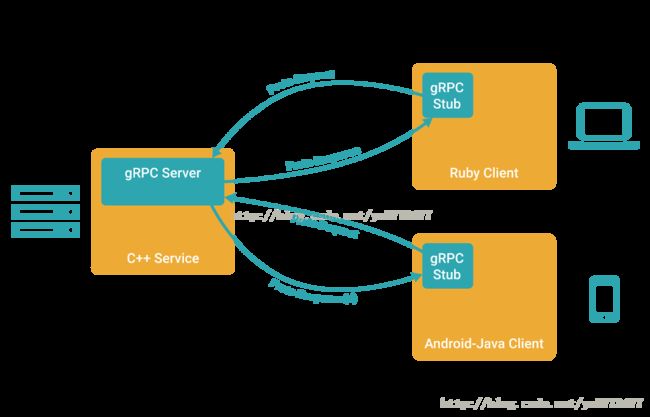go的grpc实现
gRPC是Google的RPC框架,开源、高性能、跨语言,基于HTTP/2通讯协议和Protocol Buffer 3数据序列化协议。
过程如下图所示:

调用的双方可以使用完全不同的两种语言来实现,分别实现client端和server端,按照约定的protobuf协议进行交互。client端会保存与server端的长连接对象或叫存根,通过这个存根可以直接调用服务端的方法。而服务端则实现了proto中指定的服务接口。
proto的安装
要编译proto文件生成go代码需要两个工具
- protoc :用于编译(其他语言只需要protoc足以)
- protoc-gen-go : 用于生成go语言的文件(go语言专用插件)
1、protoc-gen-go下载:
go get github.com/golang/protobuf/protoc-gen-go会直接生成protoc-gen-go 二进制文件到GOPATH的bin目录。
2、protoc下载:https://github.com/google/protobuf/releases
找到对应平台win/linux/mac的下载包,复制二进制文件protoc到GOPATH的bin目录。
定义proto文件
syntax = "proto3";
package protos;
// 要获取的数据结构
message User{
int32 id = 1;
string name = 2;
}
// 请求数据结构
message UserReq{
int32 id = 1;
}
// 定义服务,关键字'service',方法关键字'rpc'
service IUserService {
// 单一请求应答,一对一
rpc Get (UserReq) returns (User);
// 服务端流式应答,一对多,可用于下载
rpc GetList (UserReq) returns (stream User);
// 客户端流式请求,多对一,可用于上传
rpc WaitGet(stream UserReq) returns (User);
// 双向流式请求应答,支持HTTP/2.0
rpc LoopGet(stream UserReq) returns (stream User);
}编译proto生成go文件
这里要使用grpc插件选项:
protoc --go_out=plugins=grpc:. 路径/*.proto会在同目录下生成.pb.go文件。如果不识别protoc,则说明GOPATH的bin目录不在环境变量中,需要设置。
安装grpc包
go get google.golang.org/grpc实现grpc的server端
1、接口实现,即对外提供的服务API。
package service
import (
"fmt"
"io"
"log"
"protos"
"strconv"
"golang.org/x/net/context"
)
//对外提供的工厂函数
func NewUserService() *UserService {
return &UserService{}
}
//**************************************************************
// 接口实现,接口定义是在proto生成的.pb.go文件中
//**************************************************************
// 接口实现对象,属性成员根据而业务自定义
type UserService struct {
}
// Get接口方法实现
func (this *UserService) Get(ctx context.Context, req *protos.UserReq) (*protos.User, error) {
return &protos.User{Id: 1, Name: "shuai"}, nil
}
// GetList接口方法实现
func (this *UserService) GetList(req *protos.UserReq, stream protos.IUserService_GetListServer) error {
fmt.Println(*req)
// 流式返回多条数据
for i := 0; i < 5; i++ {
stream.Send(&protos.User{Id: int32(i), Name: "我是" + strconv.Itoa(i)})
}
return nil
}
// WaitGet接口方法实现
func (this *UserService) WaitGet(reqStream protos.IUserService_WaitGetServer) error {
for { // 接收流式请求并返回单一对象
userReq, err := reqStream.Recv()
if err != io.EOF {
fmt.Println("流请求~", *userReq)
} else {
return reqStream.SendAndClose(&protos.User{Id: 100, Name: "shuai"})
}
}
}
//双向流:请求流和响应流异步
func (this *UserService) LoopGet(reqStream protos.IUserService_LoopGetServer) error {
for {
userReq, err := reqStream.Recv()
if err == io.EOF { //请求结束
return nil
}
if err != nil {
return err
}
if err = reqStream.Send(&protos.User{Id: userReq.Id, Name: "shuai"}); err != nil {
return err
}
}
}
2、启动服务
package main
import (
"flag"
"fmt"
"net"
"proj/service" // 实现了服务接口的包service
"protos" // 此为自定义的protos包,存放的是.proto文件和对应的.pb.go文件
"google.golang.org/grpc"
)
var (
// 命令行参数-host,默认服务监听端口在9000
addr = flag.String("host", "127.0.0.1:9000", "")
)
func main() {
// 开启服务监听
lis, err := net.Listen("tcp", *addr)
if err != nil {
fmt.Println("listen error!")
return
}
// 创建一个grpc服务
grpcServer := grpc.NewServer()
// 重点:向grpc服务中注册一个api服务,这里是UserService,处理相关请求
protos.RegisterIUserServiceServer(grpcServer, service.NewUserService())
// 可以添加多个api
// TODO...
// 启动grpc服务
grpcServer.Serve(lis)
}go run main.go //或指定-host "localhost:9001"实现grpc的client端
package main
import (
"flag"
"fmt"
"io"
"log"
"protos" // 此为自定义的protos包,存放的是.proto文件和对应的.pb.go文件
"golang.org/x/net/context"
"google.golang.org/grpc"
)
var (
// 命令行参数-host,默认地址本机9000端口
addr = flag.String("host", "127.0.0.1:9000", "")
// UserService服务存根,可直接调用服务方法
userCli protos.IUserServiceClient
)
func main() {
// 创建grpc的服务连接
conn, err := grpc.Dial(*addr)
if err != nil {
log.Fatal("failed to connect : ", err)
}
// 存根
userCli = protos.NewIUserServiceClient(conn)
// 测试前三种数据传递方式,第四种省略(二三结合)
TestGet()
TestGetList()
TestWaitGet()
}
func TestGet() {
// 测试调用方法Get,返回user对象
user, err := userCli.Get(context.Background(), &protos.UserReq{Id: 1})
if err != nil {
fmt.Printf("Get connect failed :%v", err)
return
}
log.Println("Get响应数据:", *user)
}
func TestGetList() {
// 测试调用方法GetList,返回一个Stream流,循环获取多个user对象
recvStream, err := userCli.GetList(context.Background(), &protos.UserReq{Id: 1})
if err != nil {
fmt.Printf("GetList connect failed :%v", err)
return
}
for {
user, err := recvStream.Recv()
if err == io.EOF {
break
}
log.Println("GetList获取的一条响应数据:", *user)
}
}
func TestWaitGet() {
// 测试调用方法WaitGet,传入多条请求数据,返回一个user对象
sendStream, err := userCli.WaitGet(context.Background())
if err != nil {
fmt.Printf("WaitGet connect failed :%v", err)
return
}
for i := 0; i < 5; i++ { // 一次传入5条请求数据
if err = sendStream.Send(&protos.UserReq{Id: int32(i)}); err != nil {
fmt.Printf("WaitGet send failed :%v", err)
return
}
}
// 服务端接受全部请求数据后,返回一个user对象
user, err := sendStream.CloseAndRecv()
if err != nil {
fmt.Printf("WaitGet recv failed :%v", err)
return
}
log.Println("WaitGet响应数据:", *user)
}启动client端:
go run main.go